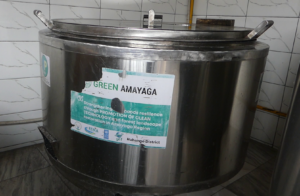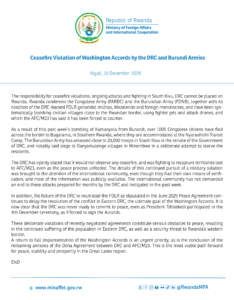By Malachie Tuyishime.
October is Breast Cancer Awareness Month or also referred to as ‘Pink October’. This month, display a pink ribbon to raise awareness about the importance of screening and early. Breast Cancer is not a transmissible or infectious disease and treatment can be highly effective, especially when the disease is identified early. There are different kinds of breast cancer depending on which cells in the breast turn into cancer. It can begin in different parts of the breast and can spread outside to other body.
Most women diagnosed with breast cancer are over the age of 50, but younger women can also get breast cancer. About 1 in 8 women are diagnosed with breast cancer during their lifetime. There’s a good chance of recovery if it’s detected at an early stage. For this reason, it’s vital that women check their breasts regularly for any changes and always have any changes examined. In rare cases, men can also be diagnosed with breast cancer.
There are several different types of breast cancer, including: Infiltrating (invasive) ductal carcinoma. Starting in your milk ducts of your breast, this cancer breaks through the wall of your duct and spreads to surrounding breast tissue. Making up about 80% of all cases, this is the most common type of breast cancer.
Ductal carcinoma in situ. Also called Stage 0 breast cancer, ductal carcinoma in situ is considered by some to be precancerous because the cells haven’t spread beyond your milk ducts. This condition is very treatable. However, prompt care is necessary to prevent the cancer from becoming invasive and spreading to other tissues.
Infiltrating (invasive) lobular carcinoma. This cancer forms in the lobules of your breast (where breast milk production takes place) and has spread to surrounding breast tissue. It accounts for 10% to 15% of breast cancers.
Lobular carcinoma in situ is a precancerous condition in which there are abnormal cells in the lobules of your breast. It isn’t a true cancer, but this marker can indicate the potential for breast cancer later on. So, it’s important for women with lobular carcinoma in situ to have regular clinical breast exams and mammograms.
Triple negative breast cancer (TNBC). Making up about 15% of all cases, triple negative breast cancer is one of the most challenging breast cancers to treat. It’s called triple negative because it doesn’t have three of the markers associated with other types of breast cancer. This makes prognosis and treatment difficult.
Inflammatory breast cancer. Rare and aggressive, this type of cancer resembles an infection. People with inflammatory breast cancer usually notice redness, swelling, pitting and dimpling of their breast skin. It’s caused by obstructive cancer cells in their skin’s lymph vessels.
Paget’s disease of the breast. This cancer affects the skin of your nipple and areola (the skin around your nipple).
Doctors know that breast cancer occurs when some breast cells begin to grow abnormally. These cells divide more rapidly than healthy cells do and continue to accumulate, forming a lump or mass. Cells may spread (metastasize) through your breast to your lymph nodes or to other parts of your body.
Breast cancer most often begins with cells in the milk-producing ducts (invasive ductal carcinoma). Breast cancer may also begin in the glandular tissue called lobules (invasive lobular carcinoma) or in other cells or tissue within the breast.
Researchers have identified hormonal, lifestyle and environmental factors that may increase your risk of breast cancer. But it’s not clear why some people who have no risk factors develop cancer, yet other people with risk factors never do. It’s likely that breast cancer is caused by a complex interaction of your genetic makeup and your environment.
Doctors estimate that about 5 to 10 percent of breast cancers are linked to gene mutations passed through generations of a family.
There are several breast cancer treatment options, including surgery, chemotherapy, radiation therapy, hormone therapy, immunotherapy and targeted drug therapy. What’s right for you depend on many factors, including the location and size of the tumor, the results of your lab tests and whether the cancer has spread to other parts of your body. Your healthcare provider will tailor your treatment plan according to your unique needs. It’s not uncommon to receive a combination of different treatments, too.
The Globocan 2020 data show that, in Rwanda, breast incidence rate is estimated at 41.0 per 100,000 women with a mortality rate of 19.4 per 100,000. Annually, breast cancer incidence in Rwanda is 16.1% of all new cancer cases (World Health Organization, 2020). Women diagnosed with breast tumours, 55% of those were diagnosed with breast cancer and 36% were diagnosed with benign tumours. For the women diagnosed with breast cancer, approximately 20% were stage one or two at diagnosis, 46% had locally progressive disease, and 31% had metastatic breast cancer.





